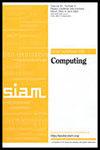动态集覆盖的确定性近最优逼近算法
IF 1.6
3区 计算机科学
Q3 COMPUTER SCIENCE, THEORY & METHODS
引用次数: 0
摘要
在动态最小集覆盖问题中,挑战是在保证近似因子接近最优的情况下最小化更新时间。(在整个,,,,中,和是参数,表示元素的最大数量、集合的数量、频率和成本范围。)在高频范围内,当,这是通过Gupta等人的具有平摊更新时间的确定性逼近算法实现的[集合覆盖的在线和动态算法,在Proceedings STOC 2017, ACM, pp. 537-550]。在本文中,我们考虑了低频范围,当,并获得了具有-近似比的确定性算法和更新时间的以下保证。(1)平摊更新时间:在我们的工作之前,确定性算法所保证的最佳近似比是Bhattacharya, Henzinger和Italiano [Design of dynamic algorithms via prial -对偶方法,in Proceedings ICALP 2015, Springer, pp. 206-218]。相比之下,使用-逼近的唯一结果是Abboud等人的结果。[动态集覆盖:改进的算法和下界,在Proceedings STOC 2019, ACM, pp. 114-125],他们设计了一个具有平摊更新时间的随机逼近算法。(2)平摊更新时间:该结果改进了上述低频范围内大多数值的更新时间界限,即。它也是第一个独立于和的结果。它包含了Bhattacharya和Kulkarni[在平摊更新时间内确定性地保持-近似最小顶点覆盖,Proceedings SODA 2019, SIAM, pp. 1872-1885]的恒定平摊更新时间,用于非加权动态顶点覆盖(即当和)。(3)最坏情况更新时间:动态集覆盖问题没有已知的非平凡最坏情况更新时间。Bhattacharya、Henzinger和Nanongkai [Proceedings SODA 2017, SIAM, pp. 470-489]的非加权动态顶点覆盖问题的最坏更新时间(即当和)的对数因子纳入并改进了我们的边界。我们通过原始对偶方法实现我们的结果,通过将分数包装解决方案维护为双重证书。在采用原始对偶方法的动态算法中,先前的工作使用了一种局部更新方案,该方案为每个集保持宽松的互补松弛条件。对于我们的第一个结果,我们使用不总是保持互补松弛条件的全局更新方案。对于第二个结果,我们将全局更新模式和本地更新模式结合起来。为了实现第三个结果,我们使用了一个后台调度器层次结构。这种后台调度技术是否也可以用于将具有平摊运行时间界限的算法转换为具有最坏情况运行时间界限的算法,这是一个有趣的开放性问题。本文章由计算机程序翻译,如有差异,请以英文原文为准。
Deterministic Near-Optimal Approximation Algorithms for Dynamic Set Cover
In the dynamic minimum set cover problem, the challenge is to minimize the update time while guaranteeing a close-to-optimal approximation factor. (Throughout, , , , and are parameters denoting the maximum number of elements, the number of sets, the frequency, and the cost range.) In the high-frequency range, when , this was achieved by a deterministic -approximation algorithm with amortized update time by Gupta et al. [Online and dynamic algorithms for set cover, in Proceedings STOC 2017, ACM, pp. 537–550]. In this paper we consider the low-frequency range, when , and obtain deterministic algorithms with a -approximation ratio and the following guarantees on the update time. (1) amortized update time: Prior to our work, the best approximation ratio guaranteed by deterministic algorithms was of Bhattacharya, Henzinger, and Italiano [Design of dynamic algorithms via primal-dual method, in Proceedings ICALP 2015, Springer, pp. 206–218]. In contrast, the only result with -approximation was that of Abboud et al. [Dynamic set cover: Improved algorithms and lower bounds, in Proceedings STOC 2019, ACM, pp. 114–125], who designed a randomized -approximation algorithm with amortized update time. (2) amortized update time: This result improves the above update time bound for most values of in the low-frequency range, i.e., . It is also the first result that is independent of and . It subsumes the constant amortized update time of Bhattacharya and Kulkarni [Deterministically maintaining a -approximate minimum vertex cover in amortized update time, in Proceedings SODA 2019, SIAM, pp. 1872–1885] for unweighted dynamic vertex cover (i.e., when and ). (3) worst-case update time: No nontrivial worst-case update time was previously known for the dynamic set cover problem. Our bound subsumes and improves by a logarithmic factor the worst-case update time for the unweighted dynamic vertex cover problem (i.e., when and ) of Bhattacharya, Henzinger, and Nanongkai [Fully dynamic approximate maximum matching and minimum vertex cover in worst case update time, in Proceedings SODA 2017, SIAM, pp. 470–489]. We achieve our results via the primal-dual approach, by maintaining a fractional packing solution as a dual certificate. Prior work in dynamic algorithms that employs the primal-dual approach uses a local update scheme that maintains relaxed complementary slackness conditions for every set. For our first result we use instead a global update scheme that does not always maintain complementary slackness conditions. For our second result we combine the global and the local update schema. To achieve our third result we use a hierarchy of background schedulers. It is an interesting open question whether this background scheduler technique can also be used to transform algorithms with amortized running time bounds into algorithms with worst-case running time bounds.
求助全文
通过发布文献求助,成功后即可免费获取论文全文。
去求助
来源期刊

SIAM Journal on Computing
工程技术-计算机:理论方法
CiteScore
4.60
自引率
0.00%
发文量
68
审稿时长
6-12 weeks
期刊介绍:
The SIAM Journal on Computing aims to provide coverage of the most significant work going on in the mathematical and formal aspects of computer science and nonnumerical computing. Submissions must be clearly written and make a significant technical contribution. Topics include but are not limited to analysis and design of algorithms, algorithmic game theory, data structures, computational complexity, computational algebra, computational aspects of combinatorics and graph theory, computational biology, computational geometry, computational robotics, the mathematical aspects of programming languages, artificial intelligence, computational learning, databases, information retrieval, cryptography, networks, distributed computing, parallel algorithms, and computer architecture.
 求助内容:
求助内容: 应助结果提醒方式:
应助结果提醒方式:


